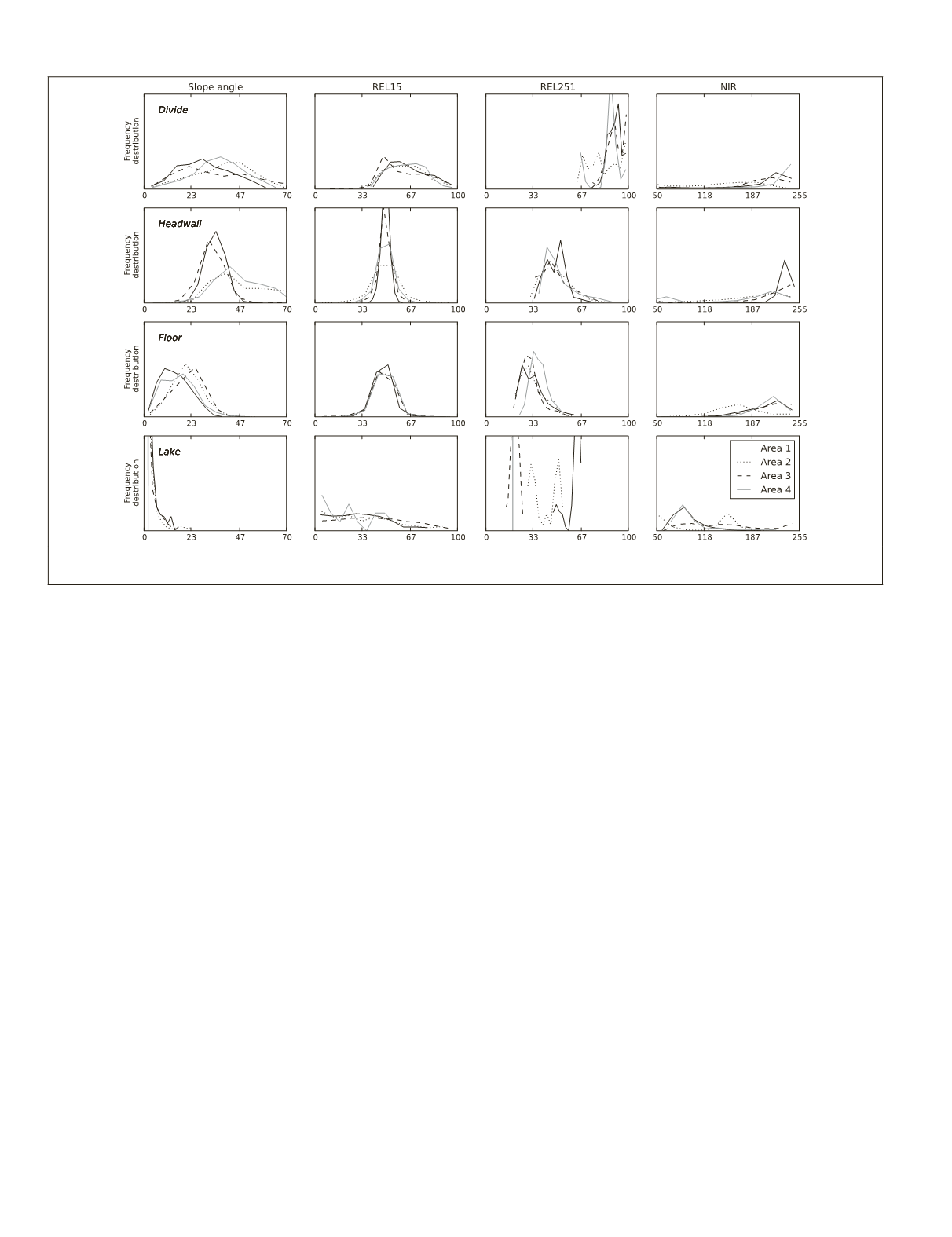
expected. Overall accuracy (71 percent) is acceptable and in
agreement with Area 1. However, there are several notice-
able differences. For example, only 59 percent of the labeled
divides are classified, thus many divides are missed, which
negatively influences the rest of the classification. Figure 3
shows lower values of relative elevation (within 251 × 251 m)
which hints at the existence of wider divides, next to the nar-
row and sharp divides in Area 1. The widest divides are most
likely missed and may explain the low producer’s accuracy.
In Area 2 floor and headwalls are also more often confused
with each other than other components. All classified cirque
lakes are correct, but a few are missed, likely due to higher
NIR
values in shallow water bodies (see also Figure 3).
Area 3 and 4 follow the same trend, but with decreasing ac-
curacies due to further morphological deviation from the com-
ponents of Area 1, particularly in Area 4 (the lowest test area)
where only 29 percent of the classified cirque floor components
are correct. Plate 3 shows the same trend where too great an
area is incorrectly classified as cirque floor. In most cirques
in the tested areas the cirque floor is separated from the main
glacial valley bottom by a steeper slope, possibly part of the
cirque threshold. This threshold is a hard boundary for the rule
set to prevent classifying floor components. In Area 4, cirque
thresholds are likely overlain by new sediments, have eroded
away, or have never fully developed morphologically, which
means that cirque floor components gradually merge with the
main glacial valley without a threshold, resulting in glacial val-
ley floors being misinterpreted as cirque floors by the rule set.
On the Transferability of Object-Based Rule Sets
This study focuses on the transferability of rule sets for the
extraction of detailed and complex geomorphological features
that contain information on their genetic history. Topographic
signatures of the cirque components and the classification
results indicate that when rule sets are adapted to local mor-
phological conditions, higher classification accuracies can be
achieved, and rule sets are transferable. This is in agreement
with Rokitnicki-Wojcik
et al
. (2011), who mentioned that inter-
nally parameterized rule sets to map coastal marsh habitats per-
formed only slightly better, in terms of classification accuracy,
than rule sets that had been externally parameterized in nearby
areas. Also Tiede
et al
. (2010) successfully applied a master rule
set for the extraction of dwellings from satellite imagery data.
Yet, although our rule set was transferable to one other area,
it was not producing accurate results in the other two test areas
due to fundamental differences with the expression of land-
forms. In the following section, issues considering the transfer-
ability of the proposed rule set are addressed, followed by a dis-
cussion on the transferability of object-based rule sets in general.
First, cirque complexes in this study area have formed in
locally different geological settings. When cirques form on
initially steeper slopes, cirque headwall and floor compo-
nents will show steeper slope signatures than in areas with a
geological setting with initially more gentle hillslopes. Since
slope angle was an important classifier to differentiate cirque
headwall and floor, the boundary conditions are trained based
on the local geological setting. To solve this, locally adapted
boundary conditions can be introduced by using local training
samples and may dramatically improve classification accuracy.
Second, the training areas are selected at different altitu-
dinal zones, which introduces variation in the duration of
glaciation, thus the degree to which glacial landforms have
evolved, and the extent to which post-glacial landscape
processes have modified the topographic signatures of “pure”
glacial landforms. In other words, the topographic signatures
of the cirque components contain different degrees of noise
due to post-glacial landscape evolution.
Third, a stratified
GEOBIA
approach was applied where clas-
sifications of a second component were dependent on the clas-
sifications of a previous component. This means that classifica-
tion error in an earlier step is transferred to a subsequent step
to create even more error. For example, cirque divide are often
Figure 3. Topographic signatures of the cirque components in the different areas, on the basis of Slope Angle, Relative Elevation within
15 × 15 m and 251 × 251 m, and NIR values.
512
June 2015
PHOTOGRAMMETRIC ENGINEERING & REMOTE SENSING


